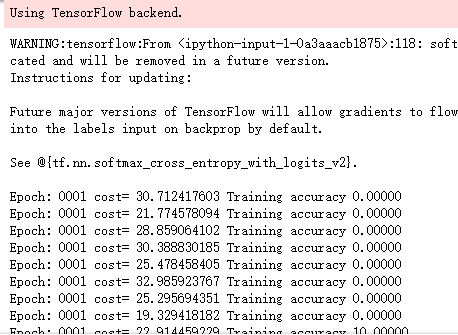# coding: utf-8
# In[1]:
import os
import numpy as np
from skimage import color, data, transform, io
# In[34]:
import tensorflow as tf
import numpy as np
train10_images = np.load('train10_images.npy')
train10_labels = np.load('train10_labels.npy')
y=tf.placeholder(tf.float32,[None,10])
def reformat(dataset, labels):
dataset = dataset.reshape((-1, 32, 32, 3)).astype(np.float32)
labels = (np.arange(10) == labels[:, None]).astype(np.float32)
return dataset, labels
train_x, train_y = reformat(train10_images, train10_labels)
## 配置神经网络的参数
n_classes = 10
batch_size = 64
kernel_h = kernel_w = 5
#dropout = 0.8
depth_in = 3
depth_out1 = 64
depth_out2 = 128
image_size = 32 ##图片尺寸
n_sample = len(train10_images) ##样本个数
x = tf.placeholder(tf.float32, [None, 32, 32, 3]) ##每张图片的像素大小为32*32
y_ = tf.placeholder(tf.float32, [None, n_classes])
keep_prob = tf.placeholder(tf.float32) ##dropout的placeholder(解决过拟合)
fla = int((image_size * image_size / 16) * depth_out2) # 扁平化用到
##定义权重变量
Weights = {"con1_w": tf.Variable(tf.random_normal([kernel_h, kernel_w, depth_in, depth_out1])),
"con2_w": tf.Variable(tf.random_normal([kernel_h, kernel_w, depth_out1, depth_out2])),
"fc_w1": tf.Variable(tf.random_normal([int((image_size * image_size / 16) * depth_out2), 512])),
"fc_w2": tf.Variable(tf.random_normal([512, 128])), "out": tf.Variable(tf.random_normal([128, n_classes]))}
##定义偏置变量
bias = {"conv1_b": tf.Variable(tf.random_normal([depth_out1])), "conv2_b": tf.Variable(tf.random_normal([depth_out2])),
"fc_b1": tf.Variable(tf.random_normal([512])), "fc_b2": tf.Variable(tf.random_normal([128])),
"out": tf.Variable(tf.random_normal([n_classes]))}
## 定义卷积层的生成函数
def conv2d(x, W, b, stride=1):
x = tf.nn.conv2d(x, W, strides=[1, stride, stride, 1], padding="SAME")
x = tf.nn.bias_add(x, b)
return tf.nn.relu(x)
## 定义池化层的生成函数
def maxpool2d(x, stride=2):
return tf.nn.max_pool(x, ksize=[1, stride, stride, 1], strides=[1, stride, stride, 1], padding="SAME")
## 定义卷积神经网络生成函数
def conv_net(x, weights, biases, dropout):
## Convolutional layer 1(卷积层1)
with tf.name_scope('convLayer1'):
conv1 = conv2d(x, Weights['con1_w'], bias['conv1_b']) ##32*32*64
tf.summary.histogram('convLayer1/weights1', Weights['con1_w'])
tf.summary.histogram('convLayer1/bias1', bias['conv1_b'])
tf.summary.histogram('convLayer1/conv1', conv1)
pool1 = maxpool2d(conv1, 2) ##经过池化层1 shape:16*16*64
## Convolutional layer 2(卷积层2)
with tf.name_scope('convLayer2'):
conv2 = conv2d(pool1, Weights['con2_w'], bias['conv2_b']) ##16*16*128
tf.summary.histogram('convLayer2/weights2', Weights['con2_w'])
tf.summary.histogram('convLayer2/bias2', bias['conv2_b'])
tf.summary.histogram('convLayer2/conv2', conv2)
pool2 = maxpool2d(conv2, 2) ##经过池化层2 shape:8*8*128
tf.summary.histogram('ConvLayer2/pool2', pool2)
flatten = tf.reshape(pool2, [-1, fla]) ##Flatten层,扁平化处理
fc1 = tf.add(tf.matmul(flatten, Weights['fc_w1']), bias['fc_b1'])
fc1r = tf.nn.relu(fc1) ##经过relu激活函数
## Fully connected layer 2(全连接层2)
fc2 = tf.add(tf.matmul(fc1r, Weights['fc_w2']), bias['fc_b2']) ##计算公式:输出参数=输入参数*权值+偏置
fc2 = tf.nn.relu(fc2) ##经过relu激活函数
## Dropout(Dropout层防止预测数据过拟合)
fc2 = tf.nn.dropout(fc2, dropout)
## Output class prediction
prediction = tf.add(tf.matmul(fc2, Weights['out']), bias['out']) ##输出预测参数
return prediction
## 优化预测准确率 0.005
prediction = conv_net(x, Weights, bias, keep_prob) ##生成卷积神经网络
cross_entropy = tf.reduce_mean(tf.nn.softmax_cross_entropy_with_logits(logits=prediction, labels=y)) ##交叉熵损失函数
optimizer = tf.train.AdamOptimizer(1e-4).minimize(cross_entropy) ##选择优化器以及学习率
merged = tf.summary.merge_all()
## 评估模型
correct_pred = tf.equal(tf.argmax(prediction, 1), tf.argmax(y, 1))
accuracy = tf.reduce_mean(tf.cast(correct_pred, tf.float32))
## 初始会话并开始训练过程
with tf.Session() as sess:
tf.global_variables_initializer().run()
# writer=tf.summary.FileWriter("./Fruits(0.001)",sess.graph)
for i in range(5):
for j in range(int(n_sample / batch_size) + 1):
start = (j * batch_size)
end = start + batch_size
x_ = train_x[start:end]
y_ = train_y[start:end]
##准备验证数据
sess.run(optimizer, feed_dict={x: x_, y: y_, keep_prob: 0.5})
loss, acc = sess.run([cross_entropy, accuracy], feed_dict={x: x_, y: y_, keep_prob: 1.})
print(
"Epoch:", '%04d' % (i + 1), "cost=", "{:.9f}".format(loss), "Training accuracy", "{:.5f}".format(acc*100))
print('Optimization Completed')
# coding: utf-8
import tensorflow as tf
from random import shuffle
INPUT_NODE = 32*32
OUT_NODE = 77
IMAGE_SIZE = 32
NUM_CHANNELS = 3
NUM_LABELS = 77
#第一层卷积层的尺寸和深度
CONV1_DEEP = 16
CONV1_SIZE = 5
#第二层卷积层的尺寸和深度
CONV2_DEEP = 32
CONV2_SIZE = 5
#全连接层的节点数
FC_SIZE = 512
def inference(input_tensor, train, regularizer):
#卷积
with tf.variable_scope('layer1-conv1'):
conv1_weights = tf.Variable(tf.random_normal([CONV1_SIZE,CONV1_SIZE,NUM_CHANNELS,CONV1_DEEP],stddev=0.1),name='weight')
tf.summary.histogram('convLayer1/weights1', conv1_weights)
conv1_biases = tf.Variable(tf.Variable(tf.random_normal([CONV1_DEEP])),name="bias")
tf.summary.histogram('convLayer1/bias1', conv1_biases)
conv1 = tf.nn.conv2d(input_tensor,conv1_weights,strides=[1,1,1,1],padding='SAME')
tf.summary.histogram('convLayer1/conv1', conv1)
relu1 = tf.nn.relu(tf.nn.bias_add(conv1,conv1_biases))
tf.summary.histogram('ConvLayer1/relu1', relu1)
#池化
with tf.variable_scope('layer2-pool1'):
pool1 = tf.nn.max_pool(relu1,ksize=[1,2,2,1],strides=[1,2,2,1],padding='SAME')
tf.summary.histogram('ConvLayer1/pool1', pool1)
#卷积
with tf.variable_scope('layer3-conv2'):
conv2_weights = tf.Variable(tf.random_normal([CONV2_SIZE,CONV2_SIZE,CONV1_DEEP,CONV2_DEEP],stddev=0.1),name='weight')
tf.summary.histogram('convLayer2/weights2', conv2_weights)
conv2_biases = tf.Variable(tf.random_normal([CONV2_DEEP]),name="bias")
tf.summary.histogram('convLayer2/bias2', conv2_biases)
#卷积向前学习
conv2 = tf.nn.conv2d(pool1,conv2_weights,strides=[1,1,1,1],padding='SAME')
tf.summary.histogram('convLayer2/conv2', conv2)
relu2 = tf.nn.relu(tf.nn.bias_add(conv2,conv2_biases))
tf.summary.histogram('ConvLayer2/relu2', relu2)
#池化
with tf.variable_scope('layer4-pool2'):
pool2 = tf.nn.max_pool(relu2,ksize=[1,2,2,1],strides=[1,2,2,1],padding='SAME')
tf.summary.histogram('ConvLayer2/pool2', pool2)
#变型
pool_shape = pool2.get_shape().as_list()
#计算最后一次池化后对象的体积(数据个数节点数像素个数)
nodes = pool_shape[1]*pool_shape[2]*pool_shape[3]
#根据上面的nodes再次把最后池化的结果pool2变为batch行nodes列的数据
reshaped = tf.reshape(pool2,[-1,nodes])
#全连接层
with tf.variable_scope('layer5-fc1'):
fc1_weights = tf.Variable(tf.random_normal([nodes,FC_SIZE],stddev=0.1),name='weight')
if(regularizer != None):
tf.add_to_collection('losses',tf.contrib.layers.l2_regularizer(0.03)(fc1_weights))
fc1_biases = tf.Variable(tf.random_normal([FC_SIZE]),name="bias")
#预测
fc1 = tf.nn.relu(tf.matmul(reshaped,fc1_weights)+fc1_biases)
if(train):
fc1 = tf.nn.dropout(fc1,0.5)
#全连接层
with tf.variable_scope('layer6-fc2'):
fc2_weights = tf.Variable(tf.random_normal([FC_SIZE,64],stddev=0.1),name="weight")
if(regularizer != None):
tf.add_to_collection('losses',tf.contrib.layers.l2_regularizer(0.03)(fc2_weights))
fc2_biases = tf.Variable(tf.random_normal([64]),name="bias")
#预测
fc2 = tf.nn.relu(tf.matmul(fc1,fc2_weights)+fc2_biases)
if(train):
fc2 = tf.nn.dropout(fc2,0.5)
#全连接层
with tf.variable_scope('layer7-fc3'):
fc3_weights = tf.Variable(tf.random_normal([64,NUM_LABELS],stddev=0.1),name="weight")
if(regularizer != None):
tf.add_to_collection('losses',tf.contrib.layers.l2_regularizer(0.03)(fc3_weights))
fc3_biases = tf.Variable(tf.random_normal([NUM_LABELS]),name="bias")
#预测
logit = tf.matmul(fc2,fc3_weights)+fc3_biases
return logit
import keras
import time
from keras.utils import np_utils
import numpy as np
trainDataList = np.load("E:\tmp\train_imgages.npy")
trainLabelNum = np.load("E:\tmp\train_labels.npy")
X = trainDataList
Y = (np.arange(77) == trainLabelNum[:,None]).astype(np.float32)
batch_size = 10
n_classes=77
epochs=16#循环次数
learning_rate=1e-4
batch_num=int(np.shape(X)[0]/batch_size)
dropout=0.75
x=tf.placeholder(tf.float32,[None,32,32,3])
y=tf.placeholder(tf.float32,[None,n_classes])
# keep_prob = tf.placeholder(tf.float32)
#加载测试数据集
testDataList = np.load("E:\tmp\test_imgages.npy")
testLabelNum = np.load("E:\tmp\test_labels.npy")
test_X = testDataList
test_Y = (np.arange(77) == testLabelNum[:,None]).astype(np.float32)
back = 64
ro = int(len(test_X)/back)
#调用神经网络方法
pred=inference(x,1,"regularizer")
cost=tf.reduce_mean(tf.nn.softmax_cross_entropy_with_logits(logits=pred,labels=y))
# 三种优化方法选择一个就可以
optimizer=tf.train.AdamOptimizer(1e-4).minimize(cost)
# train_step = tf.train.GradientDescentOptimizer(0.001).minimize(cost)
# train_step = tf.train.MomentumOptimizer(0.001,0.9).minimize(cost)
#将预测label与真实比较
correct_pred=tf.equal(tf.argmax(pred,1),tf.argmax(y,1))
#计算准确率
accuracy=tf.reduce_mean(tf.cast(correct_pred,tf.float32))
merged=tf.summary.merge_all()
#将tensorflow变量实例化
init=tf.global_variables_initializer()
start_time = time.time()
with tf.Session() as sess:
sess.run(init)
#保存tensorflow参数可视化文件
writer=tf.summary.FileWriter('C:/Fruit_graph', sess.graph)
for i in range(epochs):
for j in range(batch_num):
offset = (j * batch_size) % (Y.shape[0] - batch_size)
# 准备数据
batch_data = X[offset:(offset + batch_size), :]
batch_labels = Y[offset:(offset + batch_size), :]
sess.run(optimizer, feed_dict={x:batch_data,y:batch_labels})
result=sess.run(merged, feed_dict={x:batch_data,y:batch_labels})
writer.add_summary(result, i)
loss,acc = sess.run([cost,accuracy],feed_dict={x:batch_data,y:batch_labels})
print("Epoch:", '%04d' % (i+1),"cost=", "{:.9f}".format(loss),"Training accuracy","{:.5f}".format(acc*100))
writer.close()
print("########################训练结束,下面开始测试###################")
for i in range(ro):
s = i*back
e = s+back
test_accuracy = sess.run(accuracy,feed_dict={x:test_X[s:e],y:test_Y[s:e]})
print("step:%d test accuracy = %.4f%%" % (i,test_accuracy*100))
print("Final test accuracy = %.4f%%" % (test_accuracy*100))
end_time = time.time()
print('Times:',(end_time-start_time))
print('Optimization Completed')
